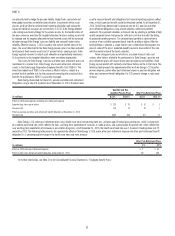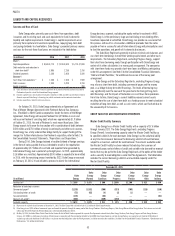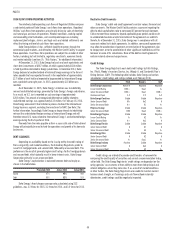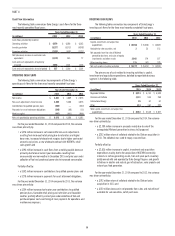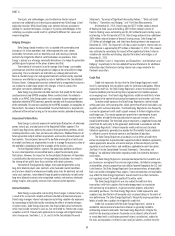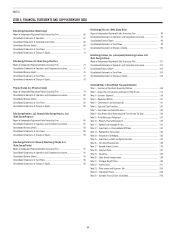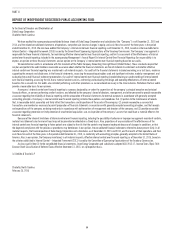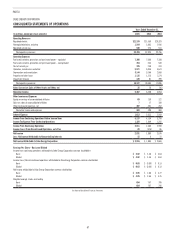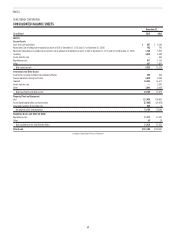Duke Energy 2015 Annual Report Download - page 81
Download and view the complete annual report
Please find page 81 of the 2015 Duke Energy annual report below. You can navigate through the pages in the report by either clicking on the pages listed below, or by using the keyword search tool below to find specific information within the annual report.
61
PART II
deposit is typically refunded. Charge-offs for retail customers have historically
been insignificant to the operations of the Duke Energy Registrants and are
typically recovered through retail rates. Management continually monitors
customer charge-offs and payment patterns to ensure the adequacy of bad
debt reserves. Duke Energy Ohio and Duke Energy Indiana sell certain of their
accounts receivable and related collections through Cinergy Receivables
Company, LLC (CRC), a Duke Energy consolidated variable interest entity.
Losses on collection are first absorbed by the equity of CRC and next by the
subordinated retained interests held by Duke Energy Ohio, Duke Energy Kentucky
and Duke Energy Indiana. See Note 17 to the Consolidated Financial Statements,
“Variable Interest Entities.”
Duke Energy Carolinas has third-party insurance to cover certain
losses related to asbestos-related injuries and damages above an aggregate
self-insured retention. Duke Energy Carolinas’ cumulative payments began to
exceed the self-insurance retention in 2008. Future payments up to the policy
limit will be reimbursed by the third-party insurance carrier. The insurance
policy limit for potential future insurance recoveries indemnification and medical
cost claim payments is $847 million in excess of the self-insured retention.
Receivables for insurance recoveries were $599 million and $616 million at
December 31, 2015 and 2014, respectively. These amounts are classified in
Other within Investments and Other Assets and Receivables on the Consolidated
Balance Sheets. Duke Energy Carolinas is not aware of any uncertainties
regarding the legal sufficiency of insurance claims. Duke Energy Carolinas
believes the insurance recovery asset is probable of recovery as the insurance
carrier continues to have a strong financial strength rating.
The Duke Energy Registrants also have credit risk exposure through
issuance of performance guarantees, letters of credit and surety bonds on
behalf of less than wholly owned entities and third parties. Where the Duke
Energy Registrants have issued these guarantees, it is possible that they could
be required to perform under these guarantee obligations in the event the obligor
under the guarantee fails to perform. Where the Duke Energy Registrants have
issued guarantees related to assets or operations that have been disposed of
via sale, they attempt to secure indemnification from the buyer against all future
performance obligations under the guarantees. See Note 7 to the Consolidated
Financial Statements, “Guarantees and Indemnifications,” for further
information on guarantees issued by the Duke Energy Registrants.
Based on the Duke Energy Registrants’ policies for managing credit risk,
their exposures and their credit and other reserves, the Duke Energy Registrants
do not currently anticipate a materially adverse effect on their consolidated
financial position or results of operations as a result of non-performance by any
counterparty.
Marketable Securities Price Risk
As described further in Note 15 to the Consolidated Financial Statements,
“Investments in Debt and Equity Securities,” Duke Energy invests in debt
and equity securities as part of various investment portfolios to fund certain
obligations. The vast majority of investments in equity securities are within the
NDTF and assets of the various pension and other post-retirement benefit plans.
Pension Plan Assets
Duke Energy maintains investments to facilitate funding the costs of
providing non-contributory defined benefit retirement and other post-retirement
benefit plans. These investments are exposed to price fluctuations in equity
markets and changes in interest rates. The equity securities held in these
pension plans are diversified to achieve broad market participation and reduce
the impact of any single investment, sector or geographic region. Duke Energy
has established asset allocation targets for its pension plan holdings, which
take into consideration the investment objectives and the risk profile with
respect to the trust in which the assets are held.
A significant decline in the value of plan asset holdings could require
Duke Energy to increase funding of its pension plans in future periods, which
could adversely affect cash flows in those periods. Additionally, a decline in
the fair value of plan assets, absent additional cash contributions to the plan,
could increase the amount of pension cost required to be recorded in future
periods, which could adversely affect Duke Energy’s results of operations in
those periods.
Nuclear Decommissioning Trust Funds
As required by the NRC, NCUC, PSCSC and FPSC, subsidiaries of Duke
Energy maintain trust funds to fund the costs of nuclear decommissioning. As
of December 31, 2015, these funds were invested primarily in domestic and
international equity securities, debt securities, cash and cash equivalents and
short-term investments. Per the NRC, Internal Revenue Code, NCUC, PSCSC
and FPSC requirements, these funds may be used only for activities related to
nuclear decommissioning. These investments are exposed to price fluctuations
in equity markets and changes in interest rates. Duke Energy actively monitors
its portfolios by benchmarking the performance of its investments against
certain indices and by maintaining, and periodically reviewing, target allocation
percentages for various asset classes. Accounting for nuclear decommissioning
recognizes that costs are recovered through retail and wholesale rates;
therefore, fluctuations in equity prices do not materially affect the Consolidated
Statements of Operations as changes in the fair value of these investments
are primarily deferred as regulatory assets or regulatory liabilities pursuant
to Orders by the NCUC, PSCSC and FPSC. Earnings or losses of the fund will
ultimately impact the amount of costs recovered through retail and wholesale
rates. See Note 9 to the Consolidated Financial Statements, “Asset Retirement
Obligations” for additional information regarding nuclear decommissioning
costs. See Note 15 to the Consolidated Financial Statements, “Investments in
Debt and Equity Securities” for additional information regarding NDTF assets.
Foreign Currency Risk
Duke Energy is exposed to foreign currency risk from investments in
international businesses owned and operated in countries outside the U.S.
and from certain commodity-related transactions within domestic operations
that are denominated in foreign currencies. To mitigate risks associated with
foreign currency fluctuations, contracts may be denominated in or indexed to
the U.S. dollar and/or local inflation rates, or investments may be naturally
hedged through debt denominated or issued in the foreign currency. Duke Energy
may also use foreign currency derivatives, where possible, to manage its risk
related to foreign currency fluctuations. To monitor its currency exchange rate
risks, Duke Energy uses sensitivity analysis, which measures the impact of
devaluation of the foreign currencies to which it has exposure.
Duke Energy’s primary foreign currency rate exposure is to the Brazilian
real. The table below summarizes the potential effect of foreign currency
devaluations on Duke Energy’s Consolidated Statement of Operations and
Consolidated Balance Sheets, based on a sensitivity analysis performed as of
December 31, 2015 and December 31, 2014.
Summary of Sensitivity Analysis for Foreign Currency Risks
Assuming 10 percent devaluation
in the currency exchange rates in
all exposure currencies
As of December 31,
(in millions) 2015 2014
Income Statement impact(a) $ (17) $ (20)
Balance Sheet impact(b) (74) (98)
(a) Amounts represent the potential annual net pretax loss on the translation of local currency earnings to the
U.S. dollar in 2015 and 2014, respectively.
(b) Amounts represent the potential impact to the currency translation through Accumulated Other
Comprehensive Income (AOCI) on the Consolidated Balance Sheets.



